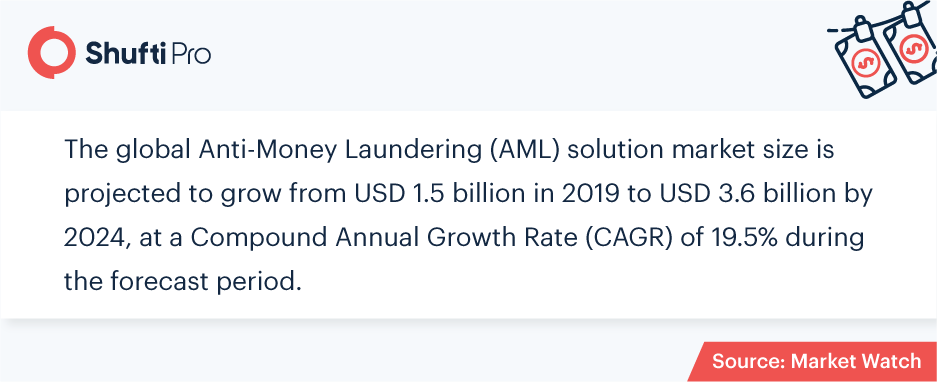Top 10 AML Trends to Watch for in 2022

- 01 1. Stringent Crypto Regulations
- 02 2. Increased Use of Artificial Intelligence
- 03 3. Emerging Technologies to Combat Crime
- 04 4. UBO Laws to Have More Transparency in 2022
- 05 5. Use of Third-Party Utilities
- 06 6. Adoption of Analytics
- 07 7. Enhanced AML Screening Solution
- 08 8. Focus on Digital Payment-Related Issues
- 09 9. Robust Transaction Monitoring Solutions
- 10 10. Information Sharing Beyond Big Banks
- 11 Final Thoughts
In 2021, the increasing scope of regulatory sanctions has affected businesses globally. The use of financial institutions for money laundering and terrorist financing was a major issue faced by most businesses. In response, global regulatory bodies have emerged with more rigid Anti-Money Laundering (AML) compliance to identify and eliminate the risk of such criminal activities.
The Philippine government came up with the AML Act, while the Hong Kong Monetary Authority (HKMA) announced new AML guidelines in April. The UAE Central Bank made suspicious activity reporting requirements in June, and Dubai also established an AML court. This year was revolutionary for AML compliance. The debate regarding cryptocurrencies and virtual asset providers also increased. However, regulators did not come up with unified laws.
As 2022 is approaching, new regulations or updates in compliance are expected, whereas businesses and financial institutions will need to be even better prepared. They will be required to comply with AML compliance and have to incorporate robust compliance frameworks that can fulfill AML screening measures. Continue reading to learn how the changes in AML regulations will influence business in 2022.
1. Stringent Crypto Regulations
Cryptocurrency has gained the attention of both regulators as well as businesses around the world. Due to anonymity and decentralization, criminals have become more sophisticated. The amount of money lost in cryptocurrency scams in 2021 was almost 30% higher than for the whole account in 2020. Thus, strengthening virtual assets regulation has become a recurring topic. Due to this reason, different regulatory bodies like FinCEN, SEC, FATF, and other watchdogs have become interested in cryptocurrency regulation in recent years. Nonetheless, this will continue in 2022 as well.
Other than this, many other countries have taken initiatives to regulate and make cryptocurrencies’ main streams, and some of them like China are all set to launch their own digital Yuan. However, by 2022, crypto exchanges will be forced to complete AML screening for every customer, a practice that will undoubtedly spread to every country on the planet soon.

2. Increased Use of Artificial Intelligence
One of the important duties that compliance officers should take on during the COVD-19 process is managing the remote compliance team and thousands of personnel. After all, the safety of financial institutions at such a period goes beyond physical boundaries. As a result, in order to meet the security and compliance standards, a remote and digital infrastructure is required.
However, artificial intelligence can assist businesses in dealing with a number of challenges emerging with digitization. It can decrease the need for human intervention, especially in situations involving money laundering prevention. Although AI may never be able to totally replace people, it can assist in reducing the need for human approval and speeding up many aspects of AML.
3. Emerging Technologies to Combat Crime
Companies can only curb the fraudulent activities with new technologies as cybercriminals are getting more devious in their approaches to carry out money laundering, terrorist financing, and various other financial crimes. The banking sector and non-financial businesses have been ordered by regulators across the globe to integrate enhanced AML software powered by advanced technologies.
Automation will be the keyword in the financial business in 2022. As businesses move forward into the future, they would implement automated compliance practices to safeguard their place in an ever-changing financial landscape in 2022.
4. UBO Laws to Have More Transparency in 2022
Efforts to develop an effective culture of transparency have also driven the need to improve clarity in Ultimate Beneficial Owner (UBO) legislation. Additionally, the more transparent momentum of UBOs will allow financial firms to sign into monetary transactions to identify the risk of money laundering. banks will implement improved Customer Due Diligence (CDD) measures to reduce financial crimes as transparency increases.
However, some countries have accepted these regulations. But, certain nations, such as Switzerland, do not plan to accept UBO regulations, hence, criminals in these nations will have easy access to shell firms next year. It’s forecasted that there will be a huge spike in money laundering and other financial crimes in such countries.
5. Use of Third-Party Utilities
Several banks are using third-party (shared utility model) services for AML compliance, transaction monitoring, risk-assessment management, and browser-based distribution of financial crime watchlists. Third-party providers’ knowledge is being used by financial institutions for AML background screening and Enhanced Due Diligence (EDD), as well as to identify emerging risks and violation tactics.
Suggested Read: Third-party Due Diligence – Red Flags, Regulations, and 5 Ways to Enhance It
6. Adoption of Analytics
Advanced filtering technologies and analytics are gaining traction for real-time fraud detection and alert production based on changes in behavior patterns. High-tech network visualization is also being used by banks to detect suspicious activities and monitor money trails. Social media analytics assist Enhanced Due Diligence (EDD) process to identify PEPs, which includes negative media screening efforts for the detection of litigations, adverse orders, and other potential hazards.
However, in 2022 financial firms will use software for background screening, which has several benefits, like shortening EDD process timeline, more informed decision-making, and robust identification of high-risk entities and UBOs.
7. Enhanced AML Screening Solution
Anti-money laundering screening is a method to assess the risk of crimes that clients can possess in businesses. With the help of a screening system, businesses can get control of the existing clients by thoroughly screening them against the global financial crime databases, PEPs lists, and watchlists. This will allow businesses to detect money laundering activities before it happens.
AML screening solution helps businesses to comply with regulatory compliance and also safeguards them from financial crimes.
- Identify the customers’ identities in less than a second, thus providing a seamless onboarding experience
- Provides global coverage, screening across 230+ countries and territories
- Screens customers against 1700+ global watchlists, including PEPs lists, global watchlists, and financial databases
- Provides real-time screening results with 98.67% accuracy
8. Focus on Digital Payment-Related Issues
Globally, regulatory authorities’ focus is primarily centered on money laundering threats linked to newly emerged payments methods like crypto wallets, e-payments, and e-money exchanges. In addition to this, utmost priority is devoted to identifying and deterring financial crimes associated with digital currencies.
9. Robust Transaction Monitoring Solutions
It is expected that regulators will demand faster methods for identifying suspicious transaction monitoring in addition to AML procedures. The use of technologies like AI, ML, and big data will be crucial in this case. Businesses will need to determine potential risk by incorporating tech-driven tools that limit false positives, and detect, analyze, and eliminate suspicious transactions.
10. Information Sharing Beyond Big Banks
The Financial Action Task Force (FATF) has urged governments and businesses to collaborate in the fight against money laundering and terrorism funding. Both parties are dealing with the same issues, particularly in regards to information: its quality, quantity, transparency, and ability to be handled effectively. While the trend toward information sharing may take time to catch on, we have already seen the first steps, such as the FinCEN Exchange in the United States, which aims to improve public-private information sharing. However, it is expected to see more similar initiatives in 2022.
Final Thoughts
Money launderers and cybercriminals will always determine innovative ways to manipulate the banking sector to carry out illicit activities. However, detecting criminal activities in time is the most difficult factor while incorporating a robust AML framework to trace, detect and eliminate the potential risk of money laundering terrorist financing, and other financial crimes.
Want to learn more about AML screening services for your business?










